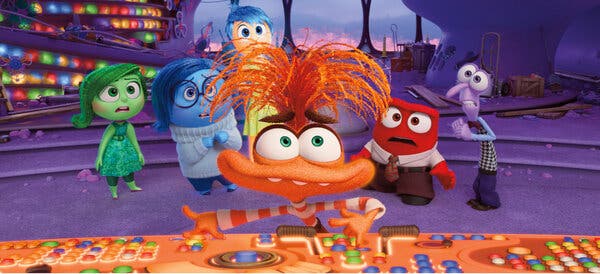While “Inside Out” originally featured five core emotions that controlled 11-year-old Riley’s actions – Joy, Sadness, Disgust, Anger, and Fear – puberty brings four more complex emotions that take root in 13-year-old Riley’s mind in “Inside Out 2.”
There’s Envy, aquamarine and perpetually jealous; Embarrassment, a lumbering, blush-pink guy who clumsily attempts to hide behind his hoodie; and Ennui (boredom), lethargic and an expert at eye-rolling.
But it’s Anxiety who takes all the attention. With her orange, gravity-defying hair and frazzled energy, Anxiety arrives in Riley’s mind with overwhelming enthusiasm to help, and has no less than six suitcases in tow.
“OK, how can I help?” she eagerly asks. “I can take notes, get coffee, manage your calendar, walk your dog, carry your things, watch you sleep?”
According to director Kelsey Mann, Anxiety was originally supposed to be the film’s antagonist. However, after consulting with clinical psychologist Lisa Damour and Dacher Keltner, an expert on the science of emotion and a psychology professor, Mann and his team decided that Anxiety’s actions were driven by love for Riley, just like all of the other emotions.
Thus, the final version of the character is mostly charming and sincere, though occasionally a bit off the rails. Her job, she believes, is to protect Riley by excessively planning for the future. By imagining all of the possible things that could go wrong, Anxiety believes she can shield Riley “from the scary stuff she can’t see.”
While the protective emotion of anxiety is there to imagine potential dangers and work to prevent them, it can become irrational and harmful when it justifies illogical fears or possibilities. For instance, in the film, Anxiety keeps Riley from sleeping by forcing mind workers to come up with a range of worst-case scenarios where she fails miserably at hockey and embarrasses herself, all in the name of protecting her.
Anxiety often overestimates threats and underestimates Riley’s ability to handle them, ultimately causing more harm than good. As a result, Riley becomes riddled with self-doubts and strays from her core morals and beliefs that form her sense of self, causing her to turn her back on her best friends to fit in with the cool kids. Riley not only believes she isn’t a good person anymore, but she also doesn’t know who she is.
Sometimes, Anxiety inadvertently holds Riley back from reaching her full potential, despite having good intentions and wanting the best for her. Yet, perhaps her obsessive focus and extensive concerns offer Riley insights that Joy can’t provide.
Ultimately, “Inside Out 2” gives people of all ages a deeper understanding of anxiety. The movie shows that anxiety isn’t a villain to be feared; rather, it is an emotion with both positive and negative sides. While Anxiety might leave her sofa chair full of concerns sometimes, she can always be gently guided back.


